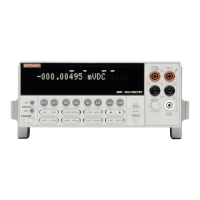Getting Started
2-16
2.6.7 Syntax rules
The following information explains some of the program-
ming syntax for the Model 2001. For more complete infor-
mation, see Programming Syntax, which is located just after
the tab labeled “SCPI Command Subsystems”.
General form
The general form for SCPI commands is demonstrated in Ta-
ble 2-7. Notice that they are hierarchical in nature and begin
with a root command. For example, to set autoranging on the
DC voltage function, you would send the following com-
mand:
:VOLT:DC:RANG:AUTO ON
The root command for the above example is [:SENSe[1]].
This is an optional command word (as indicated by the
brackets in the table) and need not be used.
Note that there must be a space between the command word
and the parameter. In the above example, there is a space be-
tween the :AUTO command word and the ON parameter.
SCPI command words and common commands are not case
sensitive. They can be sent in uppercase or lowercase. The
commands in Table 2-7 show a combination of upper and
lowercase characters. The uppercase characters identify the
short-form version of the command. For example, all the fol-
lowing versions of the same program message are valid:
:ARM:LAYER2:SOURCE MANUAL
:ARM:LAY2:SOURCE MAN
:ARM:LAY2:SOUR MAN
:arm:layer2:source manual
:arm:lay2:sour man
:Arm:Lay2:Sour Man
:ArM:LaY2:SouR MaN
Parameters
As previously mentioned, a parameter is separated from the
command word by a space character. The parameter can con-
sist of one or more data types, such as integer, real, Boolean,
string, name, or list. Some examples follow:
1. :voltage:dc:resolution 4
2. :trigger:delay 0.5
3. :display:window2:text:state on
4. :display:window2:text:data ‘Model 2001’
5. :voltage:dc:average:tcontrol moving
6. :route:scan:internal (@1:3,5)
1. 4 This integer parameter sets the DC voltage resolu-
tion to 3.5 digits.
2. 0.5 This real number parameter sets the trigger delay
period in seconds.
3. ON This Boolean parameter enables the display of
user text messages on the display, in this case, the bot-
tom line. A “1” could have been used instead. “OFF” or
“0” disables the function.
4. Model 2001 This string parameter specifies the user
text message. Single or double quotes delimit the mes-
sage. Note that the previous command must be sent to
enable the display of user text messages.
5. MOVing This name parameter specifies the mode of
the averaging or advanced digital filter.
6. (@1:3,5) This list parameter specifies an internal
scan list for the Model 2001-SCAN. Parentheses are
used to enclose the list of channels. The @ symbol must
precede the first channel in the list. A colon is used as a
separator for the range limits (channels 1 through 3).
Each channel or channel range in the list must be sepa-
rated by a comma.
Multiple commands
Multiple commands can be sent in the same message as long
as they are separated by semicolons. For example:
Instead of sending ...
:system:error?
:system:preset
You can send ...
:system:error?;preset
When the above message is sent, the first command word is
recognized as the root command. When the command parser
sees a colon after a semicolon, it resets the path pointer to the
root before processing the next command.
Proper use of the path pointer allows commands in the same
command level to be serviced without having to retype the
entire command path. For example, the command
:ARM:LAYer2:SOURce MANual moves the path pointer
down to the last command level in the path. As a result, the
:count, :delay, and :timer commands and their companion
query commands can be included in the same program mes-
sage without repeating the entire path. Some examples fol-
low:
Instead of sending ...
:arm:lay2:sour man;:arm:lay2:sour?
You can send ...
:arm:lay2:sour man;sour?

